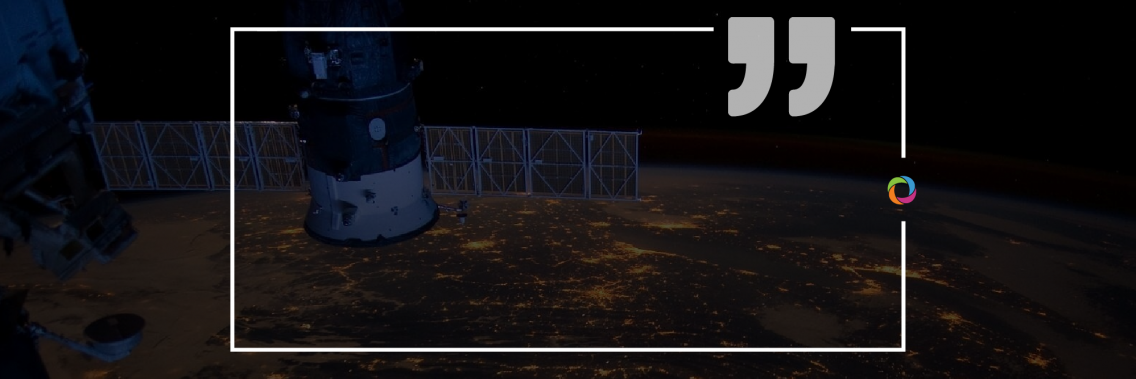There are over 1,300 satellites in space used for a variety of tasks that are essential for our networked lives… but are they so essential “on Earth” as well? Satellite technology is increasingly seen as a tool to reduce inequalities in the forthcoming crucial development decade to 2030. In which sectors can satellite technology make a difference and how? Check some opinions below.

“The satellite industry has cooperated successfully with the development sector for decades by helping communication service providers deliver cost-effective solutions for international and local internet backbone connections. The combination of affordable capacity and reduced Radio Access Network (RAN) CAPEX can be an attractive business case to ensure more resilient service delivery while reducing the digital divide. At the project level, satellite technologies make a difference by broadcasting information and live education channels, enabling connectivity for remote learning and telehealth solutions, connecting first responders and supporting humanitarian missions, and monitoring earth observation data and remote sensing. Equally relevant for development stakeholders are the current investments to surround the Earth with high throughput and low latency internet satellite constellations including Elon Musk’s SpaceX, Amazon’s Kuiper, OneWeb, O3B’s Equatorial Middle Earth Orbit (MEO), and Telesat’s Low Earth Orbit (LEO) initiatives.”

“In my opinion, satellite technology is a useful monitoring tool and has great potential for development in the agricultural and forestry sectors in the coming years. This tool helps to tackle food security and systems around the globe. Information derived from satellite observations combined with various sustainable methods to tackle climate challenges are the basics of climate-smart agriculture (CSA) techniques, according to the Food and Agriculture Organization (FAO). We will see more satellites in space in the coming decade that include Earth Observation (EO), communication, navigation, defense, and others types of satellites, around 10,000 according to the United Nations Office for Outer Space Affairs (UNOSA). The value of open access to EO satellite data provides opportunities for economic development and growth, growing research and development, knowledge sharing and governance and policymaking in low-income countries, according to the Group on Earth Observations (GEO). There is a growing need for cooperation between international, regional, and national institutes, organizations, and governments to tap into this big data stream.”

“Earth observation (EO) and geolocation (global navigation satellite systems (GNSS)) services provide free-of-charge data. This acts as a game-changer for many sectors: transport (aviation, road, maritime, rail), consumer solutions and professional applications (agriculture, forestry, construction, infrastructure monitoring). One of the highest impacts of satellites (Sentinel series) is linked with agriculture and forestry in reducing inequality (SDG #10), for example, precision agriculture to optimize crop production by combining geospatial data, e.g. on land humidity. Satellite communications (satcom) help rural/remote communities to rectify inequality by establishing internet connections with access to education. Companies propose small satellite constellations in Low Earth Orbit (LEO) or Medium Earth Orbit (MEO) to deliver the internet across the globe such as SpaceX, OneWeb, SES, Amazon, and Telesat. A new sector is Cloud computing to bring down the costs of storage and processing. For example, Microsoft has launched Azure Space with SpaceX and SES to deploy mobile cloud data centers with remote access anywhere.”

“Satellite technology largely contributes to knowledge about spatial heterogeneity and dependence. Both explain factor movement and inequality of wealth around the globe. To describe just one example, at the beginning of the 1990s the National Oceanic and Atmospheric Administration (NOAA) launched its DMSP-OLS programme of nocturnal satellite imagery, producing multi-purpose 6-bit images. The sensor technology of DMSP-OLS steadily improved and in 2012 it was replaced by VIIRS producing global monthly 14-bit images with a resolution of a few hectares. Several studies have shown the strong and significant correlation between the luminosity detected and several socio-economic and environmental variables such as GDP, electricity consumption, CO2 emissions, population density (all positive), and poverty (negative). Especially for developing countries with a lack of dependable and up-to-date data, those images with global coverage are a useful alternative to poorly designed and produced official data. Highly resolved spatial data helps to overcome the information deficit for policy at a local level for any country. Furthermore, the strong variance of light emission (especially for the range of 14-bit) makes it possible, by using statistical segmentation methods, to detect the true extent of urbanization. This insight could, for example, contribute to policy to relieve land-use conflicts along the administrative urban fringe zones.”

“In Africa, satellite technology can help bridge the North-South gap across multiple sectors. From improved telecommunications to serve daily business needs, to access to real-time situation updates for disaster and drought response, to mapping trends in land cover for planning purposes, improved access can assist African countries in meeting practically all their Sustainable Development Goals. However, as with all technology solutions to sustainable development, there is no silver bullet! Without corresponding effort to build the human and institutional capacity in African science, satellite technology may actually increase inequalities as strong African science will be needed to meet the challenges of climate change which threatens food security across the continent.”

“Satellite technology has improved communications and data-sharing capabilities in critical situations especially in places that are deprived of a telecommunications infrastructure or where phone and internet lines are cut off. Satellite communications bring basic services to underserved populations, for instance, eHealth and eLearning. In Nigeria, Inmarsat is leading a project funded in part by the UKSA’s IPP, working with research institutions and federal and state health ministries to strengthen health systems in remote areas using satellite-based training for local staff on disease surveillance capabilities and data collection. Satellite technology helps to make a difference in these areas: Ending hunger: it enable farmers to take better decisions when to add water or fertilizer and when to harvest; Clean water: satellite images enable broad and efficient monitoring of reservoir water levels, providing early warning on shortages and uniform data across different countries that share water sources, increasing transparency and consistency in water delivery; Life below water: satellites help to track and stop illegal fishing; Life on land: satellites help to monitor and protect wildlife habitation as has been done in Kenya; Good health, well-being, and quality education: access to the internet brings increased knowledge sharing.”

“Earth observations satellites, both geostationary and polar, provide invaluable data for decision-makers. Geostationary satellites hover over the same area 24/7, providing low-resolution images to monitor phenomena such as hurricanes, vegetation health, wildfires, large oil spills and have collection systems that compile data on migratory species or local weather stations. Night-time images detect illegal fishing vessels and their brightness indicates levels of economic activity in areas that do not provide economic statistics or those that are unreliable. Polar satellites provide high-resolution images which allow observations in greater detail of issues such as land use, forest cover, crop health, algal blooms and biological activity in bodies of water. Various archives of satellite images exist. When a disaster strikes, comparisons of before and after images can be made to pinpoint the specific areas damaged and to what degree. It is possible to identify buildings and structures that were completely destroyed, damaged or undamaged. Thus, satellites provide early warning for disasters and also facilitate the response. An interesting, relatively new use of satellite images is the near-real time monitoring of economic activities by, for example, counting the number of cars in the parking lots of stores or the level of oil in storage tanks.”

“Satellite technology has the furthest reach and is the most cost-effective way to connect the most remote and often underdeveloped parts of the world. Broadband VSAT data connectivity to these areas has the potential to unlock data-driven (and knowledge-based) innovations and economic activities in many rural and remote areas around the world and, more significantly, in developing countries by impacting on practically all sectors of the economy including e-learning, e-agriculture, e-government, e-health, just to name a few. It will enable remote distance learning by increasing access to e-books and also stimulate development and help develop the skills base, critical to the development of any nation. Tourism attractions gain access to much wider exposure and bookings are managed better. Agriculture and mining operations can be digitized and optimized thereby enhancing productivity. Satellite connectivity will enable many applications in the health sector including telemedicine to support and strengthen health systems and save significant costs of access to health care”.

“A satellite system constitutes really a network of networks, both for communications and for observation of the Earth. The main ability of satellites is the service to vast geographical coverage at a cost which is independent of the distance between users and in a timely manner. Satellites can provide the required connectivity on a cost-effective basis to numerous sectors. On top of the traditional applications of satellites for media (television and sound distribution) to large geographical areas, a new plethora of services can be provided by satellites in a full democratic profile: all users (either individual or entrepreneurships) can have equal access to advanced broadband services irrespective of their location (urban, suburban, rural, land, sea or sky). The combination of geostationary and non-geostationary satellites together with advanced efficiencies of the communication channels can provide an excellent mix of access to broadband services for all and low latency services (like some of the most advanced 5G based services would require). Among sectors benefiting from satellites are media, automotive, aviation, maritime, agriculture, road and railways transportation, tourism, emergency and disaster relief and environment monitoring. Satellites also provide backhaul services to many other terrestrial-based infrastructures.”

“People often think of communications when they hear about advances in satellite technology, but the benefits to the developing world from satellite technology go far beyond that. For example, satellite technology is used to monitor landslide risk. The Canadian Executive Services Organization has funded work in La Paz, Bolivia that teaches technicians in that municipality to use a form of radar called InSAR. This satellite technology is able to detect movement on slopes so technicians can target ‘hotspots’ that are at risk of landslide or instability. Space agencies around the world have for years launched satellite constellations as a global digital infrastructure for scientists and technologists to innovate and develop new applications and products. The images from these satellite constellations are often free (for example, Sentinel-1 radar images from the European Space Agency) so the costs relate only to processing and interpreting the images. Three of the many sectors served by this one example of satellite technology include critical infrastructure, urban safety, and environmental management.

“The main challenge global development will face in the coming years is the uptake of strategies to mitigate global warming. By reshaping coastal areas, affecting climate, and therefore ecosystems, global warming is a threat to the most already-vulnerable communities. Earth Observation satellites are an invaluable source of data to observe and therefore understand natural and anthropic phenomena and their consequences. In 10 years from now, the offer for satellite imagery will be uniquely diversified, accessible and affordable: large constellations of small satellites, distribution under open-data policy, high-revisit at very high resolution are some of the trends shaping the Earth Observation industry. As a consequence, it is expected that satellite imagery will be increasingly adopted when designing and implementing strategies to mitigate the impact of global warming on vulnerable communities, amongst others in the fields of disaster risk reduction, food security, and land tenure security.”

“Satellites alone as a tool to reduce inequalities may not be the only approach required, utilization of other existing and rapidly improving technology such as AI and AR will be important in the development and education of real communities. Technologies for use in the investigation of the effects of climate change along with advanced agricultural training programs can help reduce food security concerns in many areas of rural populations. Satellite data can be used to investigate historical landscape changes that have occurred over several millennia and combined with humanistic changes in agriculture and urbanism to factor best choice solutions to reduce forced migrations in highly volatile regions of the world affected by oncoming climate change.”

“From a merely technological point of view, surely satellite technology opens a wide range of possibilities in the development of less developed countries and if, in time, policy plays its part in order to make the tools and knowledge available to everyone at low costs and without any differences, it should be possible that it becomes an aid in the struggle for the reduction of inequalities. This could be in Europe, if we are able to use the tool in a fair way, or for the world, who can say. The sectors that should be more involved in the use of satellite technology should, in my opinion, be agriculture and the environment with particular regard to the defense of the territory, the prediction of catastrophic events and the management of the resulting emergencies.”
Check out more than 30 job opportunities related to Satellites, click here.

